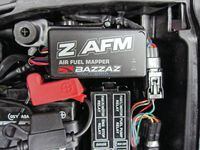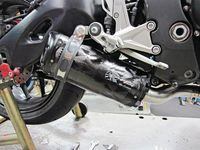Wrist: Aaron Frank
MSRP (2012): $13,800
Miles: 4370
MPG: 41
Mods: Two Brothers Racing full exhaust, Bazzaz self-mapper
Two months back I installed a Bazzaz Z-Fi fuel controller and noted that, while the “enhanced” fuel map supplied by Bazzaz was indeed better than stock mapping, the resulting air/fuel ratio (AFR) was still somewhat less than perfect—no surprise, since “perfect” fueling varies for each individual motorcycle depending on altitude, air density, and other atmospheric conditions. It’s unrealistic to expect any one map to provide perfect fueling for every bike, everywhere.
One solution is to have a tuner create a custom fuel map, but this can be time-consuming and expensive. Another option is to use the new generation of "self-mapping" modules that gather data while you ride and translate that data into an individualized map. That's what Bazzaz's Z-AFM (www.bazzaz.net; $299.95) accessory does, and I recently added one to my long-term CBR1000RR.
Because the Z-AFM requires an exhaust-mounted oxygen sensor to monitor the air-fuel mixture, first I had to install an aftermarket exhaust with the proper threaded bung to mount the O2 sensor. (Bazzaz also offers a $34.95 bung you can weld to the stock exhaust.) I selected Two Brothers Racing's V.A.L.E. Black Series full system (www.twobros.com; $1189.98), seduced by the elegant visual combination of the intricately woven carbon fiber muffler crowned with a magnesium end cap.
Installing the exhaust was straightforward, though it required skinny hands and some wrench gymnastics to install TBR’s stainless-steel header pipe without removing the radiator. I also had to clearance the frame’s exhaust hanger slightly using an angle grinder to correct some interference with the midpipe. Weighing just 9 pounds, 7 ounces complete, TBR’s full system slashed more than 11 lbs. of dead weight.
Since I had already installed the Z-Fi module, locating and connecting the Z-AFM took mere minutes—the only real task was routing the O2 sensor lead from under the bike to under the seat. With the Z-AFM hooked up and data-acquisition mode engaged—as easy as connecting to a laptop via USB, opening the Z-AFM tuning software and clicking “start”—I was ready to map.
The Z-AFM can gather data during normal street riding, but since it was late January in Wisconsin and it was snowing outside, I made my initial map on the Moon’s Supercycle dyno. Working on the dyno also ensured that I would have an accurate AFR reading at every rpm level and throttle position from 5 percent throttle at 2000 rpm to 100 percent throttle at 13,500 rpm—good luck gathering that last data point on public roads! (The Z-AFM software has a “smoothing” function that fills in any missing data points predictively when you sample on the road or racetrack.)
It took about 15 minutes on the dyno to sample all the requisite throttle positions and rpm thresholds, watching each square in the software grid change from blank to green as it was populated. Once the sampling data is collected, just click another icon to retrieve and apply the data, which is then pushed to the Z-Fi control module as a new, custom fuel map.
Where the “enhanced” map was as much as 20 percent rich or lean at certain rpm points, a close study of our Z-AFM-generated map showed AFRs that were plus or minus just one or two percent at most points across the board—very impressive results for such a quick and simple process. And with improved fueling comes more power. Peak power increased from 159.04 bhp to 163.32 bhp, with even bigger gains at the low end, adding 8 bhp at 3750 rpm and 6 bhp at 6500 revs. These gains will be felt on the street and at the track, and the Z-AFM functionality makes it easy to retune and maintain these gains when the weather warms up—or when I decide to truck the CBR a thousand miles south for a Sportbike Track Time trackday at Barber Motorsports Park in early March.













/cloudfront-us-east-1.images.arcpublishing.com/octane/QCZEPHQAMRHZPLHTDJBIJVWL3M.jpg)
/cloudfront-us-east-1.images.arcpublishing.com/octane/HXOUJXQWA5HBHGRO3EMJIGFMVI.jpg)

/cloudfront-us-east-1.images.arcpublishing.com/octane/3TIWWRV4JBBOLDVGRYECVVTA7Y.jpg)
/cloudfront-us-east-1.images.arcpublishing.com/octane/KIX5O23D5NAIBGFXBN3327DKZU.jpg)
/cloudfront-us-east-1.images.arcpublishing.com/octane/7GJYDUIPXRGMTMQKN6ONYOLBOU.jpg)
/cloudfront-us-east-1.images.arcpublishing.com/octane/MUQLOVLL2ZDGFH25ILABNBXKTI.jpg)
/cloudfront-us-east-1.images.arcpublishing.com/octane/TNOU5DNE2BC57MFPMGN2EIDXAM.jpg)
/cloudfront-us-east-1.images.arcpublishing.com/octane/GTCXACQGJ5HAPDTGWUQKDEH44E.jpg)
/cloudfront-us-east-1.images.arcpublishing.com/octane/S35YGSEMEZB4BLTDJTSZPF4GLA.jpg)
/cloudfront-us-east-1.images.arcpublishing.com/octane/5UOT6HPX2JFMRJAX6EH45AR4MQ.jpg)
/cloudfront-us-east-1.images.arcpublishing.com/octane/OKWOJWAKP5EP3OACCRRWPCIX2Q.jpg)
/cloudfront-us-east-1.images.arcpublishing.com/octane/2WF3SCE3NFBQXLDNJM7KMXA45E.jpg)
/cloudfront-us-east-1.images.arcpublishing.com/octane/G4MG6OUCJNBSHIS2MVVOTPX65E.jpg)
/cloudfront-us-east-1.images.arcpublishing.com/octane/IIGGWFOTOJGB7DB6DGBXCCMTDY.jpg)
/cloudfront-us-east-1.images.arcpublishing.com/octane/QSTCM6AVEZA5JJBUXNIQ3DSOF4.jpg)
/cloudfront-us-east-1.images.arcpublishing.com/octane/U4I7G625B5DMLF2DVIJDFZVV6M.jpg)
/cloudfront-us-east-1.images.arcpublishing.com/octane/B6XD6LS6IVCQPIU6HXDJSM3FHY.jpg)
/cloudfront-us-east-1.images.arcpublishing.com/octane/ICL63FEDDRDTTMINYICCEYGMDA.jpg)
/cloudfront-us-east-1.images.arcpublishing.com/octane/FCGZHQXRBZFLBAPC5SDIQLVF4I.jpg)
/cloudfront-us-east-1.images.arcpublishing.com/octane/WNOB6LDOIFFHJKPSVIWDYUGOPM.jpg)

/cloudfront-us-east-1.images.arcpublishing.com/octane/X33NU3E525ECRHXLNUJN2FTRKI.jpg)
/cloudfront-us-east-1.images.arcpublishing.com/octane/6KKT5NNL2JAVBOXMZYS5ZO76YA.jpg)